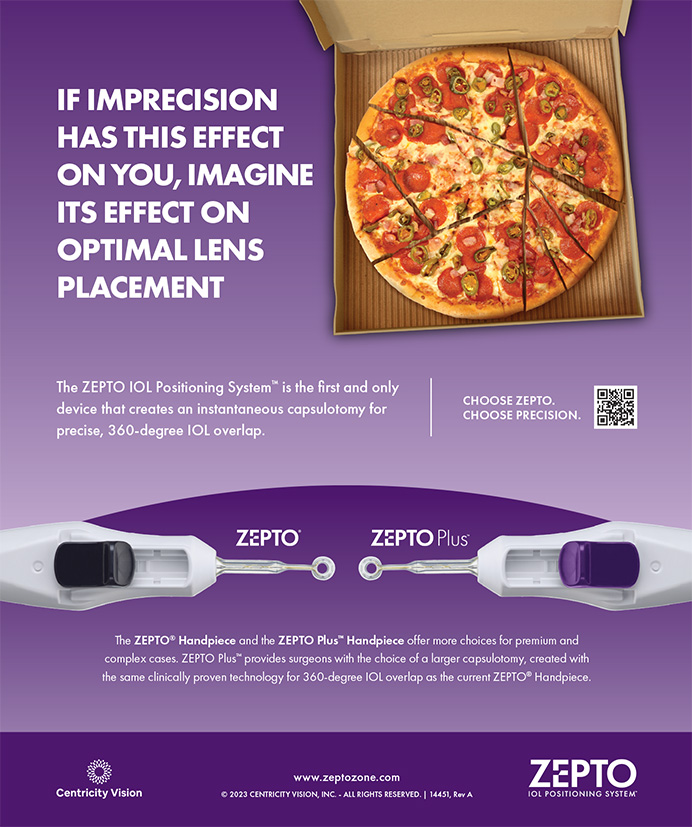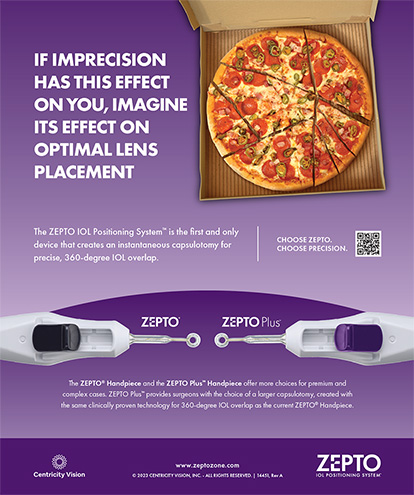Several years ago while working as a volunteer surgeon in Africa, I began tinkering with ways to divide the nucleus to facilitate small-incision extracapsular cataract extraction and stumbled onto a method that worked very well. The technique involves bringing two separate choppers across the anterior chamber, sliding them under the anterior capsulotomy, and then directing them around the nucleus to a position approximately 180º from one another. The two choppers are then brought together centrally to create a bisecting crack in the nucleus (Figures 1-4). Upon returning home, I found that this method worked superbly with phacoemulsification as well.
First performed by Jack Dodick, MD, in the 1990s, the technique of using two choppers in this manner is fast and effective, and it requires almost no practice to master. I have used this approach, which I call divide and conquer cross-chop, in the past 3,000 cases in my practice and have found it to be remarkably simple, safe, and reproducible.
TRADITIONAL DIVIDE AND CONQUER VERSUS TRADITIONAL CHOPPING MANEUVERS
In the early 1990s, John Shepherd, MD, and Howard Gimbel, MD, described the first systematic approach to disassembling the nucleus within the capsular bag, a technique that came to be called divide and conquer.1,2 Twenty year later, it continues to be the most popular method of nuclear disassembly among cataract surgeons in the United States.3 The primary advantage of divide and conquer is that it allows the surgeon to disassemble the nucleus under a very stable set of conditions. The chief disadvantages of the technique are that it is relatively slow, it places stress on the zonules associated with downward forces pushing on the nucleus, and it requires more total phaco power for nuclear disassembly than do well-performed chopping techniques.4
Various chopping methods have been described, including prechop, in which the nucleus is disassembled before phacoemulsification, and intraoperative chopping techniques, in which nuclear disassembly occurs coincident with phacoemulsification of the nucleus. Originally introduced by Takayuki Akahoshi, MD, and Jochen Kammann, MD, prechopping techniques have generally involved instruments that are designed to impale the nucleus.5 Unfortunately, surgeons sometimes find the process of impaling the nucleus cumbersome and awkward, and the force required to impale the nucleus tends to create vectors that can lead to zonular stress, even when efforts are made to create counterforces with another chopper. Moreover, during prechop with impaling devices, an inability to aspirate cortex simultaneously impairs visualization and makes it is difficult for the surgeon to judge the depth of the impaling device within the nucleus.
First described by Kunihiro Nagahara, MD, intraoperative chopping may be performed using horizontal or vertical techniques or a combination of both.5 The primary advantage of intraoperative chopping techniques is their efficiency. No phaco energy or time is wasted making the grooves needed with divide and conquer to create cracks in the nucleus. Instead, these fissures are made as an integral part of the phaco process. The chief disadvantage of intraoperative chopping is that, for optimal effectiveness, the technique requires higher vacuum levels and flow rates than does either divide and conquer or prechop. These heightened phaco parameters result in faster and less predictable movement of both nuclear material and the posterior capsule as well as less stability of the anterior chamber volume.
I believe that the main reasons why a majority of US cataract surgeons still perform divide and conquer as their primary phaco technique are as follows: the inherent awkwardness of impaling prechop techniques and the instability of the surgical field associated with intraoperative chopping techniques.
COMBINING THE BENEFITS OF THREE APPROACHES
Divide and conquer cross-chop quickly and easily divides the nucleus into quadrants without phaco energy and without placing stress on the capsule or the zonules. The compressive forces of the crossing choppers are isolated within the nucleus; they are not transmitted to the supporting structures of the lens. The maneuver is performed in a stable chamber filled with an ophthalmic viscosurgical device. The nuclear quadrants are then brought into the pupillary plane with the phaco tip without the need for high vacuum levels or high flow rates. The anterior chamber, therefore, remains stable, as in classic divide and conquer.
Dodick-Colvard Cross Choppers (Rhein Medical, Inc.) are designed to allow the surgeon to work easily over brows and cheekbones, even when the patient has deep-set eyes. The choppers are long enough to engage the nucleus effectively but, if properly positioned, not so long as to come into contact with the posterior capsule. After filling the anterior chamber with an ophthalmic viscosurgical device, the ophthalmologist introduces the cross choppers through the primary and sideport incisions. Alternatively, surgeons performing bimanual I/A may introduce the instruments through the two sideport incisions. Slight downward pressure on the choppers as they slide across the anterior surface of the cataract ensures that they pass under the capsular margins.
Surgeons new to this technique commonly fail to completely rotate the tip of the chopper in their nondominant hand. Partial rotation can place asymmetric compressive forces on the nucleus. The problem can be easily corrected and the maneuver repeated, however, if a complete initial crack is not achieved. Often, especially with soft nuclei, the first chop stirs up cortex, making visualization of the edge of the capsulotomy difficult. As long as the tips of the choppers are laid flat against the nucleus and advanced with slight downward pressure across the anterior surface of the cataract, I find that the instruments may still be easily and reliably placed under the capsule and positioned for the second chop.
CONCLUSION
Divide and conquer cross-chop provides phaco surgeons with all of the advantages of divide and conquer. The former technique is easier and faster, however, and it reduces the total phaco energy delivered to the eye. Unlike prechop, which impales the nucleus, cross-chop does not place stress on the zonules. All of the forces of cross-chop are compressive, centripetal, and counterbalanced within the capsular bag.
D. Michael Colvard, MD, is a clinical professor of ophthalmology at Doheny Eye Institute, Keck School of Medicine, University of Southern California, Los Angeles, and director of the Colvard Eye Center in Encino, California. He acknowledged no financial interest in the product or company mentioned herein. Dr. Colvard may be reached at (818) 906-2929; mike@mcolvard.com.
- Gimbel HV. Divide and conquer nucleofractis phacoemulsification: development and variations. J Cataract Refract Surg. 1991;17:281-291.
- Shepherd JR. In situ fracture. J Cataract Refract Surg. 1990;16:436-440.
- Leaming DV. Practice Styles and Preferences of US ASCRS Members—2011 Survey. Paper presented at: ASCRS/ ASOA Symposium and Congress; April 21, 2012; Chicago, IL.
- Wong T, Hingorani M, Lee V. Phacoemulsification time and power requirements in phaco chop and divide and conquer nucleofractis techniques. J Cataract Refract Surg. 2000;26:1374-1378.
- Chang DF. Phaco chop techniques. In: Colvard DM, ed. Achieving Excellence in Cataract Surgery: a Step-by-Step Approach. Santa Ana, CA: Advanced Medical Optics Inc.; 2009:39.


